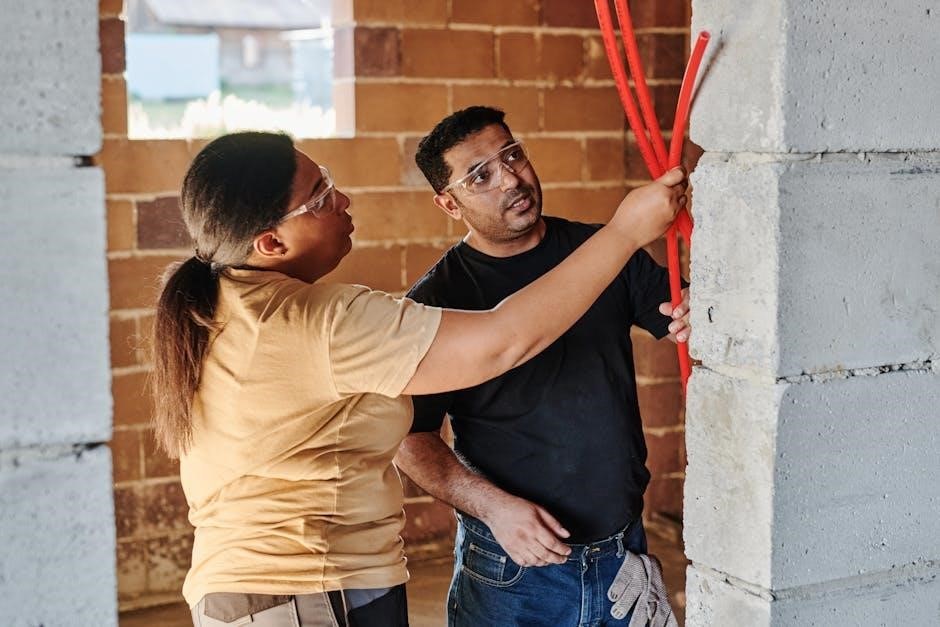Hunter Fan instruction manual provides guidance on installation and operation of ceiling fans with detailed instructions and safety precautions to ensure proper use and maintenance of the product effectively always.
Importance of Following Instructions
Following the instructions in the Hunter Fan instruction manual is crucial for the safe and proper installation and operation of the ceiling fan. The manual provides detailed guidance on how to install and maintain the fan, including important safety precautions to avoid accidents and injuries. By following the instructions, users can ensure that their ceiling fan is installed correctly and functions properly, providing optimal performance and energy efficiency. The instructions also help users to troubleshoot common issues and resolve problems quickly, reducing the risk of damage to the fan or injury to people. Additionally, following the instructions can also help to extend the lifespan of the fan and maintain its warranty. Overall, following the instructions in the Hunter Fan instruction manual is essential for the safe, efficient, and effective use of the ceiling fan. The manual is designed to be easy to follow and understand, making it simple for users to get the most out of their ceiling fan.
Overview of Hunter Fan Company History
Hunter Fan Company has a rich history dating back to 1886 when it invented the ceiling fan. Since then, the company has been a pioneer in the industry, constantly innovating and improving its products; With a commitment to quality, craftsmanship, and innovation, Hunter Fan Company has become a leading manufacturer of ceiling fans. The company’s history is marked by its dedication to pushing the boundaries of what is possible, and its products have become synonymous with comfort, performance, and style. Over the years, Hunter Fan Company has expanded its product line to include a wide range of ceiling fans, from traditional to modern designs, and has established itself as a trusted brand in the industry. Today, the company continues to innovate and produce high-quality ceiling fans that provide comfort and performance to homes and offices around the world, with a focus on durability and energy efficiency. The company’s legacy is built on its founding principles of quality and innovation.

Components of a Ceiling Fan
Ceiling fan components include motor, housing, blades, and downrod, which work together to provide airflow and comfort effectively always with proper installation and maintenance procedures in place every time.
Motor and Housing

The motor is a critical component of the ceiling fan, as it powers the blades and creates airflow. The motor is typically enclosed in a housing, which protects it from dust and other debris. The housing is usually made of a durable material, such as metal or plastic, and is designed to withstand the stresses of normal operation. The motor and housing work together to provide smooth and efficient operation of the ceiling fan. In addition to the motor and housing, the ceiling fan also includes other components, such as blades and a downrod, which are essential for its proper functioning. The motor is usually designed to be energy-efficient and to provide a high level of airflow, while also being quiet and reliable. Overall, the motor and housing are essential components of the ceiling fan, and their proper functioning is critical to its overall performance and efficiency, with proper installation and maintenance.
Blades and Downrod
The blades of the ceiling fan are designed to create airflow and circulate air in a room, and they are typically made of a lightweight material, such as wood or plastic. The downrod is a metal rod that connects the fan to the ceiling, and it is used to suspend the fan at the desired height. The length of the downrod can vary, depending on the height of the ceiling and the type of fan being installed. The blades and downrod work together to provide a high level of airflow and to create a comfortable and energy-efficient cooling system. The blades are usually reversible, allowing for both summer and winter operation, and they are designed to be durable and long-lasting. Proper installation of the blades and downrod is critical to ensure safe and efficient operation of the ceiling fan, and to prevent any potential hazards or problems. The downrod is also designed to be adjustable, allowing for customization of the fan’s height and angle.

Installation Instructions
Follow the manufacturer’s instructions carefully to ensure safe and proper installation of the ceiling fan with necessary tools and precautions always taken.
Mounting Bracket and Canopy
The mounting bracket is a crucial component in the installation of a Hunter ceiling fan, as it provides the necessary support and stability to the fan. The canopy, on the other hand, covers the mounting bracket and hides the wiring, giving the fan a sleek and finished look. To install the mounting bracket, one must first ensure that the ceiling is sturdy enough to support the weight of the fan. The bracket must then be securely attached to the ceiling using the provided hardware. The canopy is then placed over the bracket, covering any exposed wiring or screws. It is essential to follow the manufacturer’s instructions carefully to ensure that the mounting bracket and canopy are installed correctly. Proper installation of these components is vital to the safe and efficient operation of the ceiling fan. The Hunter fan instruction manual provides detailed instructions on how to install the mounting bracket and canopy.
Wiring and Electrical Connections
The wiring and electrical connections of a Hunter ceiling fan are critical to its safe and proper operation. The fan’s instruction manual provides a detailed wiring diagram to help with the installation process. It is essential to follow the manufacturer’s instructions carefully to avoid any electrical shock or fire hazards. The wiring connections should be made securely to the fan’s motor and lighting components, if applicable. The electrical connections should also be checked to ensure they are compatible with the fan’s voltage and frequency requirements. A licensed electrician may be necessary to perform the wiring and electrical connections, especially if the fan is being installed in a new location or as part of a larger electrical system. The Hunter fan instruction manual emphasizes the importance of proper wiring and electrical connections to ensure the fan operates efficiently and safely. By following the manual’s instructions, one can ensure a successful and trouble-free installation. Proper wiring is crucial for the fan’s performance.

Troubleshooting Common Issues
Hunter fan instruction manual helps resolve issues with switch functionality and lighting for optimal performance and safety always using proper methods.
Switch Functionality and Lighting
The Hunter fan instruction manual provides guidance on switch functionality and lighting, ensuring that users can operate their ceiling fans safely and efficiently. The manual outlines the proper procedures for installing and using the fan’s lighting features, including the use of dimmer switches and other control devices. It also explains how to troubleshoot common issues with the fan’s lighting, such as flickering or dimming, and provides tips for maintaining the fan’s electrical components. By following the instructions in the manual, users can enjoy optimal performance and safety from their Hunter ceiling fan. The manual’s coverage of switch functionality and lighting is comprehensive and easy to understand, making it a valuable resource for anyone installing or operating a Hunter ceiling fan. Overall, the Hunter fan instruction manual is an essential tool for getting the most out of a Hunter ceiling fan.
Resolving Installation Problems
The Hunter fan instruction manual includes a section on resolving installation problems, which provides troubleshooting tips and solutions to common issues that may arise during the installation process. This section helps users to identify and fix problems quickly and easily, ensuring that their ceiling fan is installed correctly and safely. The manual offers guidance on how to resolve issues such as uneven blade rotation, wobbling, and noise, and provides advice on how to check and adjust the fan’s installation to prevent these problems from occurring. By following the troubleshooting tips and solutions outlined in the manual, users can overcome installation challenges and enjoy a smooth and successful installation experience. The manual’s troubleshooting guide is an essential resource for anyone installing a Hunter ceiling fan, and helps to ensure that the fan is installed correctly and functions properly. This helps to prevent safety hazards and ensures optimal performance.
